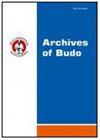The caloric cost of combat sports and martial arts training in relation to health recommendations – initial research
IF 1.5
3区 医学
Q3 SPORT SCIENCES
引用次数: 8
Abstract
Background The aim of study was to expand the knowledge about the caloric cost (CC) of trainings in selected combat sports and martial arts, in the context of daily recommended physical activity necessary for health. Material & Methods: The study was conducted in a total of 89 men who recreationally trained 3–4 times a week aikido, capoeira, jujutsu, kick boxing, kyokushin karate, traditional karate, vma (various martial arts). For the measurements of training CC, “Caltrac Monitor” accelerometers (Muscle Dynamics, Inc. Torrance, CA, USA) were used. CC of three 60-minute workouts was monitored in each of the seven tested combat sports and martial arts, and the average results were given in kilocalories per hour (kcal/h) (absolute CC of exercises). The intensity of exercises was measured by multiplicity of metabolic equivalent (MET) (index of relative CC of trainings). Absolute and relative values of CC in each martial arts were compared to health-oriented physical activity (PA) recommended by the American College of Sports Medicine. Results: We have demonstrated that the majority of men taking part in combat sports and martial arts trainings met the criteria of daily physical activity for health. Conclusions: In the further studies on CC of combat sports and martial arts practice, measurement devices should be used that allow estimation of the ratio of training exercises with low, moderate, high and very high intensities.格斗运动和武术训练的热量消耗与健康建议的关系——初步研究
背景本研究的目的是在健康所需的每日推荐体力活动的背景下,扩大对选定格斗运动和武术训练的热量消耗(CC)的了解。材料与方法:研究对象为89名男性,他们每周进行3-4次合气道、卡波埃拉、柔术、跆拳道、空手道、传统空手道、vma(各种武术)的娱乐性训练。对于训练CC的测量,“Caltrac Monitor”加速计(肌肉动力学公司)。Torrance, CA, USA)。在七个测试的格斗运动和武术中,每一个都监测了三次60分钟锻炼的CC,平均结果以每小时千卡(kcal/h)(运动的绝对CC)给出。运动强度用代谢当量(MET)(训练相对CC指数)测定。将各武术项目CC的绝对值和相对值与美国运动医学学院推荐的健康导向体力活动(PA)进行比较。结果:大多数参加搏击运动和武术训练的男性符合日常身体活动的健康标准。结论:在搏击运动与武术训练CC的进一步研究中,应采用测量装置,估算低、中、高、超高强度训练动作的比例。
本文章由计算机程序翻译,如有差异,请以英文原文为准。
求助全文
约1分钟内获得全文
求助全文
来源期刊

Archives of Budo
SPORT SCIENCES-
CiteScore
2.80
自引率
47.60%
发文量
0
审稿时长
>12 weeks
期刊介绍:
Archives of Budo is an international peer reviewed journal publishing articles on various aspects of the sports sciences covering education and research in martial arts and combat sports, and related areas like biomechanics, kinesiology, medicine, psychology, sociology, technologies of sports equipment, research in training, selection, performance, survival, and other interdisciplinary perspectives.
Archives of Budo editors endorse the principles embodied in the Helsinki Declaration and expect that all research involving humans has been performed in accordance with these principles. All human studies must have been approved by the investigator''s Institutional Review Board. A copy of the relevant documentation should be included with the manuscript. Furthermore Archives of Budo follows the ICMJE''s Recommendations for the Conduct, Reporting, Editing and Publication of Scholarly Work in Medical Journals.
Archives of Budo provides free, immediate and permanent online access to the full text of all articles distributed under the terms of the Creative Commons Attribution Non-commercial License http://creativecommons.org/licenses/by-nc/4.0), which permits use, distribution, and reproduction in any medium, provided the original work is properly cited, the use is non-commercial and is otherwise in compliance with the license.
 求助内容:
求助内容: 应助结果提醒方式:
应助结果提醒方式:


